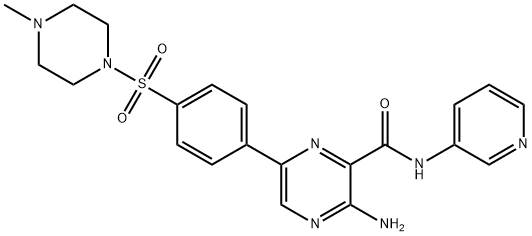Description
AZD2858 is a selective GSK-3 inhibitor with an IC50 of 68 nM, activating Wnt signaling, increases bone mass in rats.
In vitro
AZD2858 is a selective GSK-3 inhibitor with an IC50 of 68 nM, inhibits tau phosphorylation at the S396 site, activates Wnt signaling pathway. AZD2858 treatment (1 μM, 12 h) on primary isolated human osteoblast-like cells results in a 3-fold increase of β-catenin levels. AZD2858 causes β-catenin stabilisation in human and rat mesenchymal stem cells, stimulates hADSC commitment towards osteoblasts and osteogenic mineralisation in vitro.
In vivo
In rats, oral AZD2858 treatment causes a dose-dependent increase in trabecular bone mass compared to control after a two-week treatment with a maximum effect at a dose of 20 mg/kg once daily (total BMC: 172% of control). A small but significant effect is also seen at cortical sites (total BMC: 111% of control). AZD285 treatment (30 μmol/kg) on rats daily for up to 3 weeks shows an increase in both mineral density (of 28% at 2 weeks and 38% at 3 weeks) and mineral content (of 81% at 2 weeks and 93% at 3 weeks) in the calluses. AZD285 treatment makes the fractures heals more rapidly, with a bony callus without an obvious endochondral component. AZD2858 produces time-dependent changes in serum bone turnover biomarkers and increases bone mass over 28 days exposure in rats. After 7 days, AZD2858 increases the bone formation biomarker P1NP, and reduces the resorption biomarker TRAcP-5b, indicating increased bone anabolism and reduced resorption in rats.
Uses
AZD 2858 is a highly selective glycogen synthase kinase-3β (GSK3β) inhibitor used in the treatment of neurological diseases such as Alzheimer’s (1).
Definition
ChEBI: AZD2858 is a member of the class of pyrazines that is pyrazine substituted by (pyridin-3-yl)aminocarbonyl, amino, and 4-(4-methylpiperazine-1-sulfonyl)phenyl groups at positions 2, 3 and 6, respectively. It is a potent inhibitor of GSK3alpha and GSK3beta (IC50 values of 0.9 and 4.9 nM, respectively) and increases bone mass (via Wnt activation) in rats. It has a role as an EC 2.7.11.26 (tau-protein kinase) inhibitor, an antineoplastic agent, a bone density conservation agent and a Wnt signalling activator. It is a member of pyrazines, a secondary carboxamide, a member of pyridines, a N-methylpiperazine, a sulfonamide and an aromatic amine.




